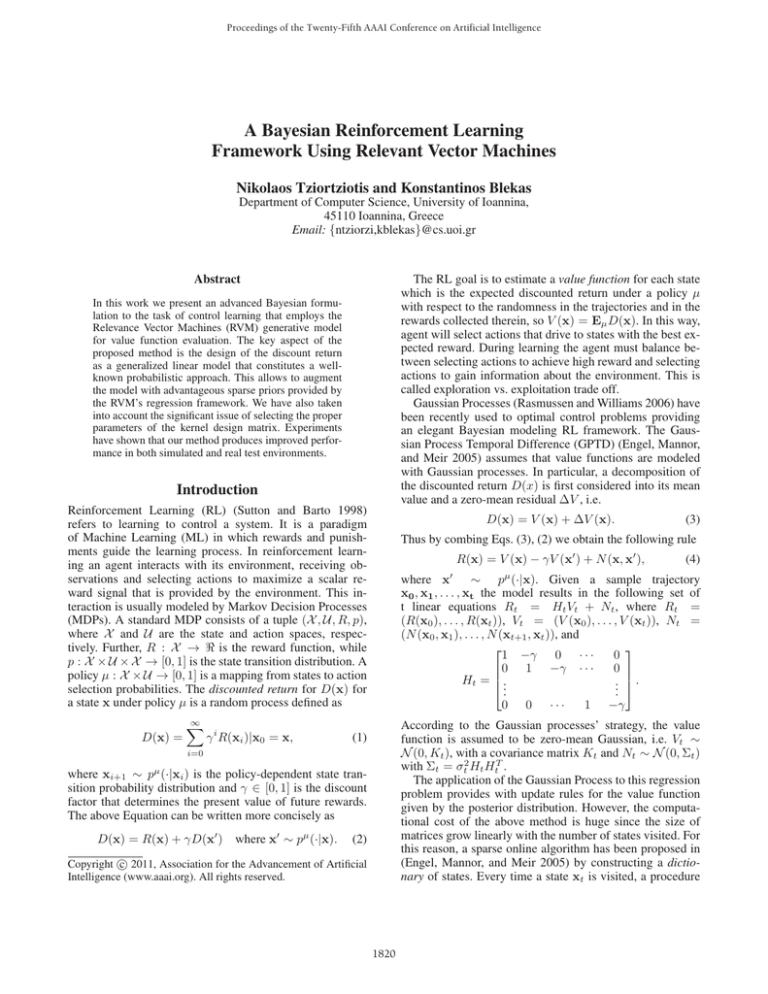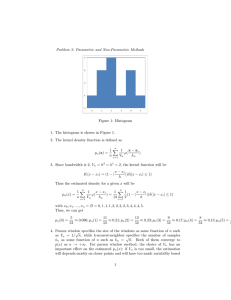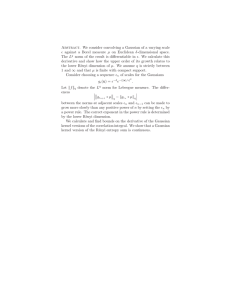
Proceedings of the Twenty-Fifth AAAI Conference on Artificial Intelligence
A Bayesian Reinforcement Learning
Framework Using Relevant Vector Machines
Nikolaos Tziortziotis and Konstantinos Blekas
Department of Computer Science, University of Ioannina,
45110 Ioannina, Greece
Email: {ntziorzi,kblekas}@cs.uoi.gr
The RL goal is to estimate a value function for each state
which is the expected discounted return under a policy μ
with respect to the randomness in the trajectories and in the
rewards collected therein, so V (x) = Eμ D(x). In this way,
agent will select actions that drive to states with the best expected reward. During learning the agent must balance between selecting actions to achieve high reward and selecting
actions to gain information about the environment. This is
called exploration vs. exploitation trade off.
Gaussian Processes (Rasmussen and Williams 2006) have
been recently used to optimal control problems providing
an elegant Bayesian modeling RL framework. The Gaussian Process Temporal Difference (GPTD) (Engel, Mannor,
and Meir 2005) assumes that value functions are modeled
with Gaussian processes. In particular, a decomposition of
the discounted return D(x) is first considered into its mean
value and a zero-mean residual ΔV , i.e.
Abstract
In this work we present an advanced Bayesian formulation to the task of control learning that employs the
Relevance Vector Machines (RVM) generative model
for value function evaluation. The key aspect of the
proposed method is the design of the discount return
as a generalized linear model that constitutes a wellknown probabilistic approach. This allows to augment
the model with advantageous sparse priors provided by
the RVM’s regression framework. We have also taken
into account the significant issue of selecting the proper
parameters of the kernel design matrix. Experiments
have shown that our method produces improved performance in both simulated and real test environments.
Introduction
Reinforcement Learning (RL) (Sutton and Barto 1998)
refers to learning to control a system. It is a paradigm
of Machine Learning (ML) in which rewards and punishments guide the learning process. In reinforcement learning an agent interacts with its environment, receiving observations and selecting actions to maximize a scalar reward signal that is provided by the environment. This interaction is usually modeled by Markov Decision Processes
(MDPs). A standard MDP consists of a tuple (X , U , R, p),
where X and U are the state and action spaces, respectively. Further, R : X → is the reward function, while
p : X × U × X → [0, 1] is the state transition distribution. A
policy μ : X × U → [0, 1] is a mapping from states to action
selection probabilities. The discounted return for D(x) for
a state x under policy μ is a random process defined as
D(x) =
∞
γ i R(xi )|x0 = x,
D(x) = V (x) + ΔV (x).
Thus by combing Eqs. (3), (2) we obtain the following rule
R(x) = V (x) − γV (x ) + N (x, x ),
0
0
···
1
−γ
According to the Gaussian processes’ strategy, the value
function is assumed to be zero-mean Gaussian, i.e. Vt ∼
N (0, Kt ), with a covariance matrix Kt and Nt ∼ N (0, Σt )
with Σt = σt2 Ht HtT .
The application of the Gaussian Process to this regression
problem provides with update rules for the value function
given by the posterior distribution. However, the computational cost of the above method is huge since the size of
matrices grow linearly with the number of states visited. For
this reason, a sparse online algorithm has been proposed in
(Engel, Mannor, and Meir 2005) by constructing a dictionary of states. Every time a state xt is visited, a procedure
(1)
where xi+1 ∼ pμ (·|xi ) is the policy-dependent state transition probability distribution and γ ∈ [0, 1] is the discount
factor that determines the present value of future rewards.
The above Equation can be written more concisely as
where x ∼ pμ (·|x).
(4)
μ
where x
∼ p (·|x). Given a sample trajectory
x0 , x1 , . . . , xt the model results in the following set of
t linear equations Rt = Ht Vt + Nt , where Rt =
(R(x0 ), . . . , R(xt )), Vt = (V (x0 ), . . . , V (xt )), Nt =
(N (x0 , x1 ), . . . , N (xt+1 , xt )), and
⎡
⎤
1 −γ 0 · · ·
0
0 ⎥
⎢0 1 −γ · · ·
Ht = ⎢
.
.. ⎥
⎣ ...
. ⎦
i=0
D(x) = R(x) + γD(x )
(3)
(2)
c 2011, Association for the Advancement of Artificial
Copyright Intelligence (www.aaai.org). All rights reserved.
1820
is performed in order to decide whether or not to be entered into the dictionary. This is made by examining if its
feature space image φ(xt ) can be approximated sufficiently
by the existing dictionary with a maximum allowed square
error. The sparse version of GPTD makes further some approximations for calculating efficiently the kernel matrix Kt
with a reduced computational cost (Engel, Mannor, and Meir
2005).
sparse Bayesian methodology offers an advanced solution
by introducing sparse priors that has been successfully employed in the Relevance Vector Machine (RVM) model (Tipping 2001). In particular, a heavy tailed prior distribution
is imposed on the regression parameters that causes to zero
out most of them and maintain only a few which are considered significant after training. RVM has the advantages
to increase the flexibility of the inference process, to control
automatically the model complexity and to avoid overfitting.
Sparse prior is defined in a hierarchical way by considering first a zero-mean Gaussian distribution over wn , where
their precision are considered as hyperparameters following
a Gamma hyperprior. This two-stage hierarchical prior is
actually a Student’s-t distribution that provides sparseness
to the model. Training of the RVM under the maximumlikelihood framework, leads to closed form update equations
that are applied iteratively until convergence (Tipping 2001).
Special care has also been given to the construction of the
design matrix. During our study we have adopted the Gaussian kernel function K(xi , xj ) = exp(−|xi − xj |2 /(2λ)),
which is governed by the scalar parameter λ. As experiments
have shown, this parameter plays an important role that may
affect significantly the system performance. We have introduced here a multi-kernel scheme by assuming a mixture
M
of M kernel matrices Φn =
m=1 um Φnm . Each design
matrix has its own kernel parameter value λm and a weight
M
um , where m=1 um = 1. During the RVM training, there
mixing weights {um } are estimated by considering a convex
quadratic programming problem with constraints (equalities
and inequalities). Experiments have shown that the proposed
scheme improves significantly the performance and makes
the method independent on the scalar parameter choice.
The proposed method has been experimentally studied to
known simulated environments, such as the Cart-pole and
the Mountain Car, as well as to several simulated and real
environments of a Pioneer/PeopleBot mobile robot which is
built on the P3-DX base. Comparisons has been made using
the sparse version of the GPTD and the typical SARSA(λ)
temporal difference algorithm (Sutton and Barto 1998). Our
approach manages to yield significantly better asymptotic
performance in higher rate and to improve learning process.
The proposed method
The contribution of the proposed method is twofold: First it
establishes a better value function modeling with the use of
a sparse Bayesian framework. At a second level it manages
to overcome some limitations of the GPTD and its sparse
version, arisen from the enormous computational complexity that lead to approximated solutions. Our scheme deals
with the construction of a proper state dictionary and the
Bayesian formulation of the cumulative discounted rewards
between successive states entered in the dictionary. Using
the stationarity of the MDP we may rewrite the discount return (Eq. 2) for a visited state xt as
D(xt ) = SR(xt ) + γ kt D(xt+kt ) ,
(5)
kt −1 j
where SR(xt ) =
j=0 γ R(xt+j ) is the partial discount return of the state-reward sequence
xt , R(xt ), . . . , xt+kt −1 , R(xt+kt −1 ), and kt is the time
difference between successive samples entering in the
dictionary. Using the above formulation and considering the
decomposition of GPTD (Eq. 3) we can obtain the next rule:
SR(xt ) = V (xt ) − γ kt V (xt+kt ) + N (xt , xt+kt ) ,
(6)
kt
where N (xt , xt+kt ) = ΔV (xt ) − γ ΔV (xt+kt ). Therefore, for each sample x̃n inserted into the dictionary, we can
obtain a set of n model equations for states {x̃1 , . . . , x̃n }:
SRn = Hn Vn + Nn ,
(7)
where SRn = (SR(x̃1 ), . . . , SR(x̃n )), while matrix Hn
takes the following form
⎡
⎤
1 −γ k1
0
···
0
⎢0
0 ⎥
1
−γ k2 · · ·
⎢
⎥
Hn = ⎢ .
.. ⎥ .
⎣ ..
. ⎦
0
0
···
1 −γ kn
Acknowledgement
This work was partially supported by Hellenic Artificial Intelligence Society (EETN).
In our approach, we further assume that the sequence of
value function Vn = (V (x̃1 ), . . . , V (x̃n )) can be described
as a linear model, i.e. Vn = Φn wn , where Φn is a kernel
design matrix of size n × n, while wn is the vector of the
(unknown) model regression coefficients. Thus, Equation 7
can be written as
yn = Φn wn + en ,
References
Engel, Y.; Mannor, S.; and Meir, R. 2005. Reinforcement
learning with gaussian processes. In 22nd International
Conference on Machine Learning, 201–208.
Rasmussen, C., and Williams, C. 2006. Gaussian Processes
for Machine Learning. The MIT Press.
Sutton, R., and Barto, A. 1998. Introduction to reinforcement learning. MIT Press Cambridge, USA.
Tipping, M. E. 2001. Sparse Bayesian Learning and the
Relevance Vector Machine. Journal of Machine Learning
Research 1:211–244.
(8)
(HnT Hn )−1 HnT SRn .
In the above formulation
where yn =
the term en plays the role of the model noise and is assumed to be zero mean Gaussian with spherical covariance,
i.e. en ∼ N (0, βn−1 I) (βn−1 is the precision parameter).
Thus, the policy estimation problem is turned into a regression coefficients estimation problem. In this direction,
1821





